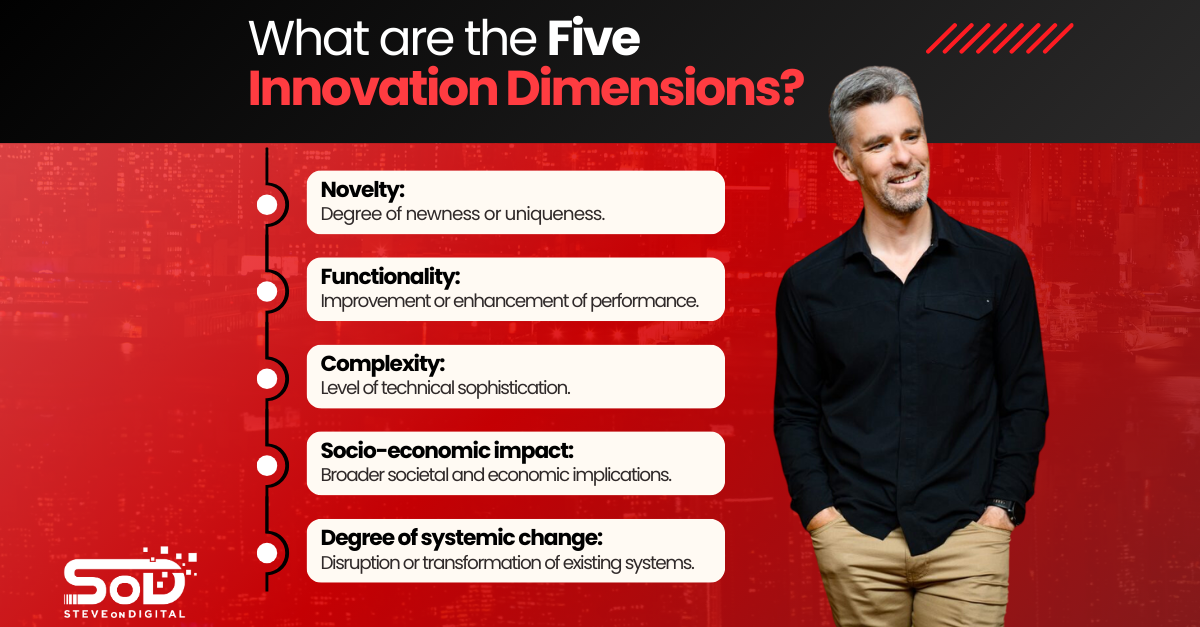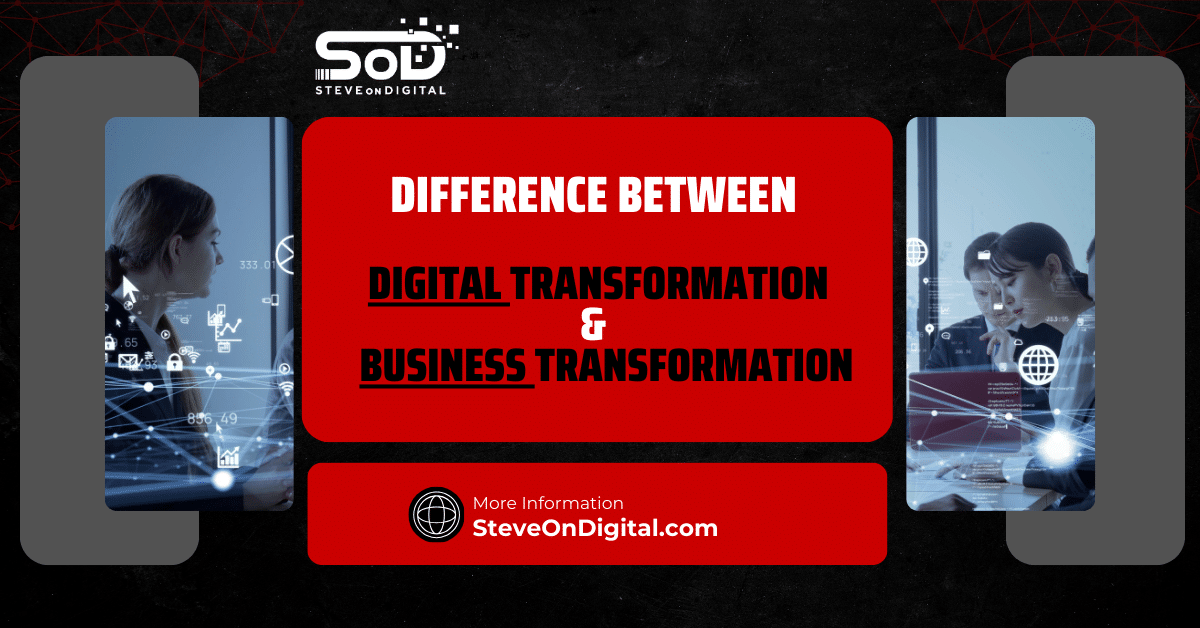In today’s fast-paced world, innovation isn’t just a buzzword; it’s the backbone of any successful business, especially for small and medium-sized enterprises (SMEs).
Hi, I’m Steve Johnston from SteveOnDigital, and having navigated the digital transformation landscape through both calm and turbulent waters, I’ve witnessed firsthand the power and necessity of innovation.
With a background in electrical engineering, an MBA, and a master’s in Project Management, I’ve dedicated my career to demystifying digital technology for SMEs.
It’s not just about keeping up; it’s about leading the way.
Grasping the key dimensions of innovation—product innovation, process innovation, business model innovation, network innovation, and brand innovation—is essential for businesses aiming to maintain a competitive edge.
This understanding is pivotal for successful innovation, ensuring that companies can navigate through the evolving demands of the marketplace and technological landscape.
It’s not just about introducing a new product or tweaking your marketing strategy; it’s about a holistic approach to transforming your business model, processes, and even the culture within your organization.
This guide aims to shed light on what these dimensions of innovation are and why they’re vital for SMEs striving to make a mark in the digital era.
Understanding Innovation Dimensions
Definition Of Innovation
Innovation, at its core, is about introducing something new.
But it’s not just any new thing; it’s about bringing forth ideas, products, or methods that add value – value for your business, your customers, and your stakeholders.
It’s the engine that drives progress, efficiency, and differentiation in a crowded market.
Overview Of The Five Innovation Dimensions
Innovation is multi-faceted; it’s not a one-size-fits-all concept. It spans across:
- Product Innovation: This is what most people think of when they hear “innovation.” It’s about developing new products or significantly improving existing ones to meet emerging customer needs or to open up new markets.
- Process Innovation: Here, the focus shifts to how things are done. It’s about enhancing or developing new processes to improve efficiency, reduce costs, or improve quality, thereby offering additional value to customers and a competitive edge to the business.
- Business Model Innovation: This dimension is about rethinking your business model. It involves changing the way business is done, in terms of capturing value (think of how subscription models have revolutionized software sales). It’s about being innovative in how you create, deliver, and capture value.
- Network Innovation: No business is an island. Network innovation focuses on the relationships and alliances a company forms. It’s about collaborating with partners, suppliers, and even competitors to create new offerings or reach new markets.
- Brand Innovation: Lastly, brand innovation revolves around how a company’s brand is perceived. It’s about crafting and evolving a brand’s image, voice, and experience to resonate deeply with current and potential customers, thereby driving loyalty and differentiation.
Significance Of Each Dimension In The Current Business And Technological Landscape
In the digital age, these dimensions of innovation are more relevant than ever.
Digital technology not only enables but also accelerates innovation across all these dimensions.
For SMEs, understanding and implementing these dimensions can mean the difference between leading the pack and playing catch-up.
- Product Innovation is being revolutionized by digital technology and artificial intelligence, enabling SMEs to offer tailored, sophisticated solutions previously only achievable by larger firms.
- Process Innovation benefits immensely from advancements in digital workflows, cloud computing, and automation, allowing smaller businesses to operate with unprecedented efficiency and agility.
- Business Model Innovation has seen a significant shift with the advent of digital platforms, e-commerce, and the sharing economy, opening up new revenue streams and ways to engage with customers.
- Network Innovation is facilitated by digital platforms that connect businesses with potential partners worldwide, making it easier to forge productive alliances and co-create value.
- Brand Innovation leverages digital marketing, social media, and content creation to build compelling brand narratives that engage and captivate a digital-savvy audience.
Each of these dimensions offers a unique lever for growth and competitive advantage.
By understanding and applying them, SMEs can navigate the complexities of the digital marketplace with greater confidence and success.
Overview of the Five Innovation Dimensions
| Dimension | Description |
| Product Innovation | Involves developing new products or significantly improving existing ones to meet emerging customer needs or tap into new markets. |
| Process Innovation | Focuses on enhancing or developing new processes to improve efficiency, reduce costs, or improve quality, thus offering additional value to customers. |
| Business Model Innovation | Changes how a business creates, delivers, and captures value, often through the adoption of new technologies and strategies. |
| Network Innovation | Revolves around the formation of strategic partnerships and collaborations to fuel innovation and expand market reach. |
| Brand Innovation | Entails the evolution of a brand’s image, voice, and customer experience to enhance perception and drive loyalty. |
Dimension 1: Product Innovation
Innovation is the heart of growth and sustainability, especially in the digital age we’re navigating today.
As Steve Johnston from SteveOnDigital, I’ve seen firsthand how innovation can transform businesses, particularly through product innovation.
This dimension of innovation focuses on developing new products or significantly improving existing ones.
It’s about meeting emerging needs or tapping into new markets, a process often fueled by digital technology and artificial intelligence (AI).
Digital technology and AI have revolutionized product innovation, enabling businesses to create smarter, more efficient, and more user-friendly products.
From AI-driven analytics tools that predict customer behavior to IoT devices that revolutionize home security, technology is at the forefront of new product development.
One standout example is the evolution of smartwatches, which have transcended their initial utility to become indispensable health and communication tools.
For SMEs, the opportunity to leverage product innovation is immense.
Concentrating on niche markets or distinct customer challenges, SMEs can leverage their innovative business models and specialized capabilities to surpass larger industrial incumbent firms.
This strategic focus on target customers, combined with the application of disruptive innovations and digital technology, enables smaller enterprises to achieve successful innovations and carve out a competitive advantage in their sectors.
A practical approach is to integrate AI to personalize offerings or use cloud-based platforms to speed up the development process, making innovation both accessible and cost-effective.
Dimension 2: Process Innovation
While product innovation captures the spotlight, process innovation is the unsung hero that enhances efficiency, reduces costs, and improves quality.
It involves rethinking the ways in which products or services are created and delivered.
In my experience, integrating digital transformation strategies into operational processes has been a game-changer for SMEs.
The impact of digital transformation on operational processes cannot be overstated.
Automation and cloud computing, for example, streamline operations, freeing up valuable resources and reducing errors.
During my tenure with SteveOnDigital, I’ve witnessed SMEs achieve remarkable efficiency gains by adopting tools like workflow automation software and project management platforms, leading to significant cost savings and improved customer satisfaction.
Case studies across various industries highlight the transformative potential of process innovation.
A local bakery, for example, might implement an inventory management system powered by AI to predict stock levels and reduce waste, while a manufacturing firm could use 3D printing to produce parts on-demand, slashing lead times and inventory costs.
The key for SMEs is to identify bottlenecks in their current processes and explore digital solutions that can address these challenges.
This often requires a mindset shift, viewing technology not as an expense but as an investment in future profitability.
Dimension 3: Business Model Innovation
Business model innovation is perhaps the most profound dimension of innovation, as it reimagines the very foundation on which businesses operate.
This approach involves changing how a company creates, delivers, and captures value.
In the digital era, innovative business models have disrupted industries, from streaming services upending traditional media to ride-sharing apps challenging conventional taxi services.
Digital technology plays a pivotal role in the innovation of business models, introducing transformative concepts such as platforms, subscriptions, and freemium models.

These innovative business models leverage technology to create additional value for target customers, showcasing the power of business model innovation in today’s digital era.
For instance, cloud computing has allowed businesses to offer as-a-service models, providing customers with flexible, scalable solutions that would have been unthinkable a couple of decades ago.
Guidance for SMEs looking to innovate their business models centers on understanding their unique value proposition and how technology can enhance it.
For example, a consulting firm might develop a subscription-based online platform offering virtual advisory services, expanding their market reach beyond geographical limitations.
Dimension 4: Network Innovation
In our digitally interconnected marketplace, the concept of Network Innovation stands out as a key dimension in driving the growth and sustainability of businesses.
By emphasizing partnerships and collaborations, Network Innovation leverages the combined strengths and capabilities of various partners, aligning with the business alignment and innovative business models to foster successful innovations.
As Steve Johnston, the face behind SteveOnDigital, I’ve observed and facilitated the transformation of SMEs through strategic partnerships and collaborations, highlighting the undeniable value of network innovation.
This dimension extends beyond the confines of a single organization, leveraging the strengths, capabilities, and market reach of multiple entities to create something truly groundbreaking.
Partnerships and collaborations serve as the lifeblood of network innovation, enabling businesses to tap into new markets, technologies, and expertise.
For instance, a small tech startup collaborating with a larger enterprise can gain access to resources and customer bases that would otherwise be out of reach, significantly accelerating its growth trajectory.
Successful examples of network innovation are abundant across industries.
A notable case is the collaboration between automotive giants and tech firms to develop autonomous driving technologies, merging traditional manufacturing excellence with cutting-edge AI and machine learning capabilities.
Such alliances not only advance technological frontiers but also reshape industry landscapes.
For SMEs looking to build and leverage business networks, the key is to identify potential partners whose goals, values, and capabilities complement their own.
Engaging in industry forums, leveraging professional networking platforms, and participating in collaborative innovation hubs are practical steps to forge these valuable connections.
Dimension 5: Brand Innovation
In the era of digital technology, Brand Innovation transcends traditional logos and slogans, focusing instead on crafting a dynamic brand image and voice that deeply engages target customers.
This dimension of innovation emphasizes the creation of a compelling brand experience, utilizing digital marketing strategies to foster customer loyalty and differentiate in the competitive marketplace.
In my journey with SteveOnDigital, I’ve seen how powerful a well-innovated brand can be in capturing customer attention and fostering loyalty.

Brand innovation involves reimagining how your brand engages with customers, often leveraging digital channels to create more personalized, interactive experiences.
The impact of brand innovation on customer perception and loyalty cannot be overstated.
In an era where consumers are bombarded with countless marketing messages, a unique, authentic brand can cut through the noise, creating a lasting connection.
Digital platforms offer unprecedented opportunities to tell your brand’s story in creative ways, from social media campaigns that go viral to immersive AR experiences that bring products to life.
Strategies for SMEs to innovate their brand include focusing on storytelling, embracing social responsibility, and leveraging technology to create immersive customer experiences.
For instance, a small coffee shop that shares the stories behind its beans, supports sustainable farming practices, and offers a virtual reality tour of its suppliers’ farms can create a powerful, differentiated brand presence in a crowded market.
Case studies of SMEs achieving significant impact through brand innovation often highlight the importance of authenticity and customer engagement.
A local apparel brand, for example, that uses its platform to promote body positivity and inclusivity can build a deeply loyal customer base, turning buyers into brand advocates.
Integrating The Five Dimensions
Understanding and integrating the five dimensions of innovation—Product, Process, Business Model, Network, and Brand Innovation—is essential for SMEs striving to thrive in today’s dynamic business environment.
These dimensions are interconnected, each reinforcing and amplifying the others.
For instance, a new product innovation can lead to process improvements, necessitate a business model shift, spur new partnerships, and require a fresh brand marketing strategy.
For SMEs, adopting a holistic approach to innovation means recognizing that these dimensions are not standalone initiatives but parts of a cohesive strategy aimed at driving sustainable growth and competitive advantage.
It involves a continuous process of evaluation, adaptation, and integration, ensuring that innovations in one area are aligned with and supported by advancements in others.
A practical framework for SMEs to assess and integrate multiple dimensions of innovation starts with identifying core strengths and market opportunities.
From there, businesses can pinpoint which dimension(s) offer the most immediate potential for growth or differentiation and then explore how innovations in that area can drive improvements across the board.
Regularly revisiting and revising this strategy as the market and technology evolve is crucial for sustained success.
Leadership And Culture In Innovation
The Role Of Visionary Leaders In Fostering An Innovative Culture
Visionary leaders are the torchbearers of innovation.
Their ability to envision the future, challenge the status quo, and encourage risk-taking is crucial for cultivating an innovative culture.
Such leaders inspire their teams, promoting a culture where new ideas are welcomed and failure is seen as a stepping stone to success.
In my own journey, adopting a leadership stance that encourages experimentation and learning has been instrumental in navigating digital transformation.
Developing Specialized Capabilities Within Teams
Building teams with specialized capabilities is another cornerstone of fostering innovation.
By investing in continuous learning and development, we empower our employees with the skills needed to innovate.

At SteveOnDigital, we prioritize cross-functional training and encourage our team to stay abreast of the latest technologies and strategies, ensuring that our innovative efforts are grounded in expertise and diverse perspectives.
The Significance Of Governance Setup In Supporting Innovation
Effective governance structures are essential for nurturing innovation.
They provide a framework within which creative ideas can be explored, developed, and implemented.
A well-structured governance setup ensures that innovation aligns with the overall business strategy, balancing creativity with practicality.
It’s about creating a pathway that turns innovative ideas into tangible value creation for the business and our customers.
Overcoming Challenges And Leveraging Opportunities
| Challenge | Strategy |
| Keeping up with technology | Invest in continuous learning and technology adoption to stay ahead. |
| Resource constraints | Leverage partnerships and external resources to extend capabilities. |
| Market competition | Focus on niche markets and unique value propositions to differentiate. |
| Scaling innovation | Develop scalable business models and processes to support growth. |
| Regulatory compliance | Stay informed on industry regulations and integrate compliance into innovation planning. |
Identifying And Addressing Common Challenges In Innovation
Innovation is not without its challenges.
Resistance to change, resource constraints, and fear of failure are common hurdles.
Overcoming these challenges requires a holistic approach – one that addresses cultural, structural, and operational barriers.
By fostering an environment that supports risk-taking and emphasizes the value of learning from failures, we can turn these challenges into opportunities for growth.
Capitalizing On Untapped Potential And Emerging Trends
The digital era is rich with untapped potential and emerging trends.
Whether it’s the advent of artificial intelligence, the rise of digital platforms, or the shift towards sustainability, opportunities for innovation are boundless.
At SteveOnDigital, we keep our finger on the pulse of these trends, using them as a springboard for innovation.

Maintaining agility and responsiveness allows businesses to capitalize on untapped potential and emerging trends, leveraging digital technologies and innovative strategies to transform these opportunities into sustainable competitive advantages.
This proactive stance ensures that companies can navigate the complexities of the marketplace and lead with successful innovations.
Utilizing Digital Technologies To Enhance Innovation Capabilities
Digital technologies are key enablers of innovation.
From cloud computing and big data analytics to AI and IoT, these tools can dramatically enhance our innovation capabilities.
By integrating digital technologies into our innovation processes, we can streamline operations, personalize customer experiences, and create more value, thereby reinforcing our business model and innovation strategy.
Case Studies And Success Stories
Reflecting on our journey, several case studies stand out, exemplifying the successful implementation of the five dimensions of innovation.
| Company Name | Innovation Dimension | Impact Achieved |
| TechGadget Inc. | Product Innovation | Launched a groundbreaking wearable device that monitors health metrics, leading to a 150% sales increase. |
| EcoSolutions | Process Innovation | Implemented a new sustainable manufacturing process, reducing waste by 40% and costs by 20%. |
| StreamLine | Business Model Innovation | Introduced a subscription-based model for their software, resulting in a 200% increase in recurring revenue. |
| LinkUp | Network Innovation | Partnered with local businesses for a joint marketing campaign, doubling their customer base. |
| Brandify | Brand Innovation | Revamped their brand identity and online presence, leading to a 300% increase in social media engagement. |
One notable example is a project where we leveraged AI to revolutionize a client’s customer service operations, significantly enhancing efficiency and customer satisfaction.
Another instance saw us redesigning a traditional business model into a digital platform, opening up new revenue streams and expanding market reach.
These success stories are a testament to the power of embracing the five dimensions of innovation, showcasing the transformative impact they can have on SMEs.
They serve as a source of inspiration and a blueprint for others embarking on their innovation journey.
Conclusion
As we wrap up this exploration of the five dimensions of innovation, I hope to have illuminated the path for SMEs striving to innovate in the digital age.
Leadership, culture, and a strategic approach to overcoming challenges are pivotal in this journey.
At SteveOnDigital, we’re committed to assisting SMEs in navigating this terrain, leveraging our expertise to unlock the full potential of digital innovation.
Innovation is not just a buzzword; it’s a necessary evolution for staying relevant and competitive.
I encourage all SMEs to embrace these dimensions of innovation, integrating them into your business strategies for sustained growth and success.
As we continue on this exciting journey of innovation, remember that SteveOnDigital is here to guide you every step of the way.
Together, let’s transform challenges into opportunities, driving forward into a future where innovation leads the way.





